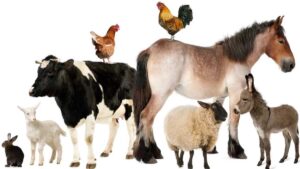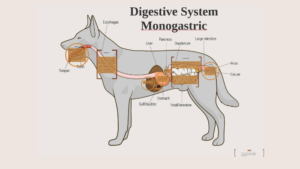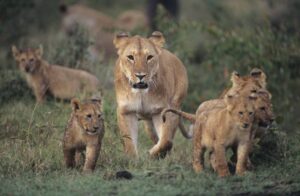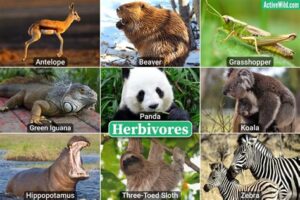Back to: Pre Vocational Studies JSS 1
Welcome to class!
In today’s class, we’re going to be talking about classification of farm animals. I trust you will enjoy the class!
Introduction
Farm animals are domesticated animals raised for various purposes, such as food, labor, and companionship. They can be classified based on their diet, habitat, and other characteristics. Let’s explore some common classifications of farm animals.
Classification of Farm Animals
Ruminants

- Definition: Ruminants are animals that have four stomachs and chew their cud. They are herbivores and primarily eat grasses and other plant matter.
- Examples: Cattle, sheep, goats, deer, and giraffes.
- Characteristics:
- Four-chambered stomachs (rumen, reticulum, omasum, and abomasum) for efficient digestion of plant material.
- Cud chewing: regurgitating partially digested food and chewing it again to break it down further.
- Hooved feet for walking on various terrains.
- Social behavior: often live in herds and form strong bonds.
- Specialized digestive system: Ruminants have a unique digestive system adapted to break down tough plant fibers. Their first stomach, the rumen, contains microorganisms that help to ferment and break down cellulose.
Monogastrics

- Definition: Monogastrics are animals with a single-chambered stomach. They can be herbivores, carnivores, or omnivores.
- Examples: Pigs, poultry (chickens, ducks, turkeys), rabbits, and guinea pigs.
- Characteristics:
- Single-chambered stomach for digestion.
- Diverse diets: can eat a variety of plants, animals, or both.
- Different habitats: can live in various environments, including farms, forests, and urban areas.
- Specialized adaptations: Monogastrics have adaptations that allow them to consume a wider range of foods. For example, pigs have omnivorous teeth that can grind both plants and meat.
Carnivores

- Definition: Carnivores are animals that primarily eat meat.
- Examples: Dogs, cats, foxes, and wolves.
- Characteristics:
- Sharp teeth and claws for hunting and tearing meat.
- Strong digestive systems for processing meat.
- Carnivorous diets: primarily consume other animals.
- Specialized adaptations: Carnivores have adaptations such as sharp claws, powerful jaws, and keen eyesight for hunting and capturing prey.
Herbivores

- Definition: Herbivores are animals that primarily eat plants.
- Examples: Cattle, sheep, goats, horses, rabbits, and guinea pigs.
- Characteristics:
- Flat teeth for grinding plants.
- Digestive systems adapted to break down cellulose, the main component of plant cell walls.
- Herbivorous diets: primarily consume grasses, leaves, and other plant matter.
- Specialized adaptations: Herbivores have adaptations such as long, flexible necks for reaching high branches, strong teeth for grinding plants, and specialized digestive systems for breaking down cellulose.
Omnivores
- Definition: Omnivores are animals that eat both plants and animals.
- Examples: Pigs, chickens, ducks, turkeys, and humans.
- Characteristics:
- Diverse diets: can consume a variety of foods.
- Adaptations for both plant and animal consumption.
- Omnivorous teeth and digestive systems that can process both plant and animal matter.
Domesticated vs. Wild Animals
- Domesticated Animals: Animals that have been bred for specific purposes by humans. Examples include cattle, sheep, goats, pigs, poultry, horses, and dogs.
- Wild Animals: Animals that live in their natural habitats and are not domesticated by humans. Examples include lions, tigers, elephants, and deer.
Beyond Diet
- Habitat: Farm animals can also be classified based on their habitat, such as terrestrial (land-dwelling) or aquatic.
- Size: Animals can be classified based on their size, such as large, medium, or small.
- Reproduction: Animals can be classified based on their reproductive strategies, such as live birth or egg-laying.
Summary
Farm animals can be classified based on their diet, habitat, and other characteristics. Understanding these classifications can help us appreciate the diversity of farm animals and their importance in our lives.
We have come to the end of today’s class. I hope you enjoyed the class!
In the next class, we shall be discussing the uses of farm animals.
In case you require further assistance or have any questions, feel free to ask in the comment section below, and trust us to respond as soon as possible. See you in the next class!
